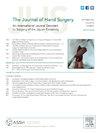日本普通老年人群中舟状方梯形、桡腕关节和远端桡尺关节原发性骨关节炎的患病率及相关因素
IF 2.1
2区 医学
Q2 ORTHOPEDICS
引用次数: 0
摘要
目的:舟方关节(STTJ)、桡腕关节(RCJ)和远端桡尺关节(DRUJ)的原发性骨关节炎(OA)的发病率和病因尚不清楚。本研究的目的是在一项基本居民登记的横断面研究中评估原发性手腕骨关节炎的患病率和相关因素。方法:随机抽取日本某城镇50 ~ 89岁居民1297人进行调查。对所有受试者进行问卷调查,每位受试者均接受双侧手、手腕和肘部x线片检查。根据先前描述的方法评估STTJ、RCJ和DRUJ影像学骨关节炎(ROA)。记录STTJ和DRUJ ROA的相关因素。研究了肘关节ROA发生率、尺侧方差和肘关节ROA严重程度之间的关系。结果:共676例腕关节(男性162例,女性176例;平均年龄69.0岁)。STTJ、RCJ和DRUJ ROA患病率分别为5.3%、1.5%和21.2%。与STTJ型ROA相关的因素有拇指腕掌关节ROA、女性性别和年龄增长。与DRUJ ROA相关的因素有肘关节ROA、使用振动工具、年龄增长和尺侧方差阳性。重度肘关节ROA患者腕部的DRUJ ROA患病率为54.4%。重度肘关节ROA患者的腕尺变异明显大于轻度或非肘关节ROA患者。结论:ROA的发生率以中枢性出血热最高,STTJ次之,RCJ最低。STTJ和DRUJ的ROA发生受相邻关节ROA存在的影响。临床相关性:原发性DRUJ ROA发生频率中等,与其他肢体关节的原发性ROA相似;然而,原发性STTJ和RCJ ROA是罕见的。本文章由计算机程序翻译,如有差异,请以英文原文为准。
Prevalence and Associated Factors for Primary Osteoarthritis of the Scaphotrapeziotrapezoid, Radiocarpal, and Distal Radioulnar Joints in the Japanese General Elderly Population
Purpose
The incidence and etiology of primary osteoarthritis (OA) of the scaphotrapeziotrapezoid joint (STTJ), radiocarpal joint (RCJ), and distal radioulnar joint (DRUJ) remains unknown. The purpose of this study was to evaluate the prevalence and factors associated with primary wrist OA in a cross-sectional study of a basic resident registry.
Methods
A total of 1,297 residents between the ages of 50 and 89 years were randomly sampled from the registry of a Japanese town. A questionnaire was administered to all subjects, and each of them underwent radiographs of the bilateral hands, wrists, and elbows. STTJ, RCJ, and DRUJ radiographic osteoarthritis (ROA) were evaluated according to a previously described method. Associated factors for STTJ and DRUJ ROA were recorded. Associations between the incidence of ROA of the DRUJ, ulnar variance, and severity of elbow ROA were investigated.
Results
A total of 676 wrists (162 men and 176 women; mean age of 69.0 years) were investigated. The prevalence of STTJ, RCJ, and DRUJ ROA was 5.3%, 1.5%, and 21.2%, respectively. Factors associated with STTJ ROA were thumb carpometacarpal joint ROA, female sex, and increasing age. Factors associated with DRUJ ROA were elbow ROA, use of vibrating tools, increasing age, and positive ulnar variance. Prevalence of DRUJ ROA was 54.4% in wrists with severe-grade elbow ROA. Ulnar variance of the wrist in severe-grade elbow ROA was significantly larger than that in mild-grade or nonelbow ROA.
Conclusions
The prevalence of ROA was highest in the DRUJ, followed by the STTJ, and lowest in the RCJ. The occurrence of ROA of the STTJ and DRUJ was affected by the presence of ROA of the adjacent joint.
Clinical relevance
Primary DRUJ ROA occurs at a moderate frequency, similar to primary ROA of other extremity joints; however, primary STTJ and RCJ ROA is rare.
求助全文
通过发布文献求助,成功后即可免费获取论文全文。
去求助
来源期刊
CiteScore
3.20
自引率
10.50%
发文量
402
审稿时长
12 weeks
期刊介绍:
The Journal of Hand Surgery publishes original, peer-reviewed articles related to the pathophysiology, diagnosis, and treatment of diseases and conditions of the upper extremity; these include both clinical and basic science studies, along with case reports. Special features include Review Articles (including Current Concepts and The Hand Surgery Landscape), Reviews of Books and Media, and Letters to the Editor.

 求助内容:
求助内容: 应助结果提醒方式:
应助结果提醒方式:


